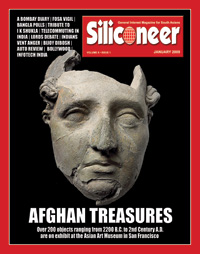EDITORIAL:
Hidden Treasures of Afghanistan
 Afghanistan conjures up images of fierce fighting, bloodshed, the Taliban, medieval Islamic values. Lost in the shuffle is its rich, thousand-year-old history. Afghanistan conjures up images of fierce fighting, bloodshed, the Taliban, medieval Islamic values. Lost in the shuffle is its rich, thousand-year-old history.
In 1978, on windswept plains of northern Afghanistan, archaeologists unearthed tombs of ancient nomads that had been sealed for two thousand years and discovered some 22,000 individual pieces of gold buried with the remains of six Bactrian Central Asian nomads. Within months of this discovery at Tillya Tepe, the country descended into war, and the so-called Bactrian Hoard disappeared. Twenty-five years later, in 2003, Afghanistan surprised the world by announcing that the priceless artifacts had been located intact in Kabul. They had been rescued, along with other masterpieces of the National Museum, Kabul, and protected in the intervening years of turmoil by a group of selfless Afghan heroes who have come to be known as “the key holders.”
Strategically located on the commercial routes between China and India in the east and Europe in the west, Afghanistan was at the crossroads of civilizations in Central Asia. “Afghanistan: Hidden Treasures from the National Museum, Kabul,” now on exhibit at the Asian Art Museum, explores the rich cultural heritage of ancient Afghanistan from the Bronze Age (2500 BC) through the rise of trade along the Silk Road in the first century AD.
The exhibition features nearly 230 artworks, including gold objects from the famed Bactrian Hoard, bronze and stone sculptures, ivories, painted glassware, and other ancient Afghan works of art.
We carry a detailed pictorial article in this month’s issue.
In the wake of the terror attacks in Mumbai, Sapna Shahani, like millions the citizens of the financial capital of India, was shocked, outraged. She decided to do something about it. She wanted to mobilize ordinary citizens and give them a voice and a space in a circus-like atmosphere completely usurped by the sensationalist media and posturing politicians.
It started off modestly enough, as Shahani and a friend communicated with other ordinary people. Their initial modest vigil mushroomed into a huge public outpouring of grief, outrage and concern.
It was by no means always an easy camaraderie; tempers were frayed at times, there were occasional bitter arguments, but the effort gave ordinary people a much-needed space to reflect and explore the broader social ramifications of what had happened.
Shahani writes about her experience in this month’s issue.
Times are tough, and the commute is lousy in most metropolitan cities in India. No wonder telecommuting is catching on.
With current recession beginning to bite, companies like IBM, American Express, GE, and software giants such as Wipro, Infosys, TCS, are taking a fresh look at the home office concept to cut costs, while improving efficiency and productivity.
Experts estimate cost savings of up to 15-20 percent with manpower utilizing up to 25 percent of work hours from home.
Especially at call centers, the working hours can be unusual, given the need to keep U.S., time, and companies are realizing that apart from areas connected to privacy, control and data security issues, a lot of functions requiring less supervision and less face-to-face interaction can be done from home.
This month’s issue has a detailed article.
|